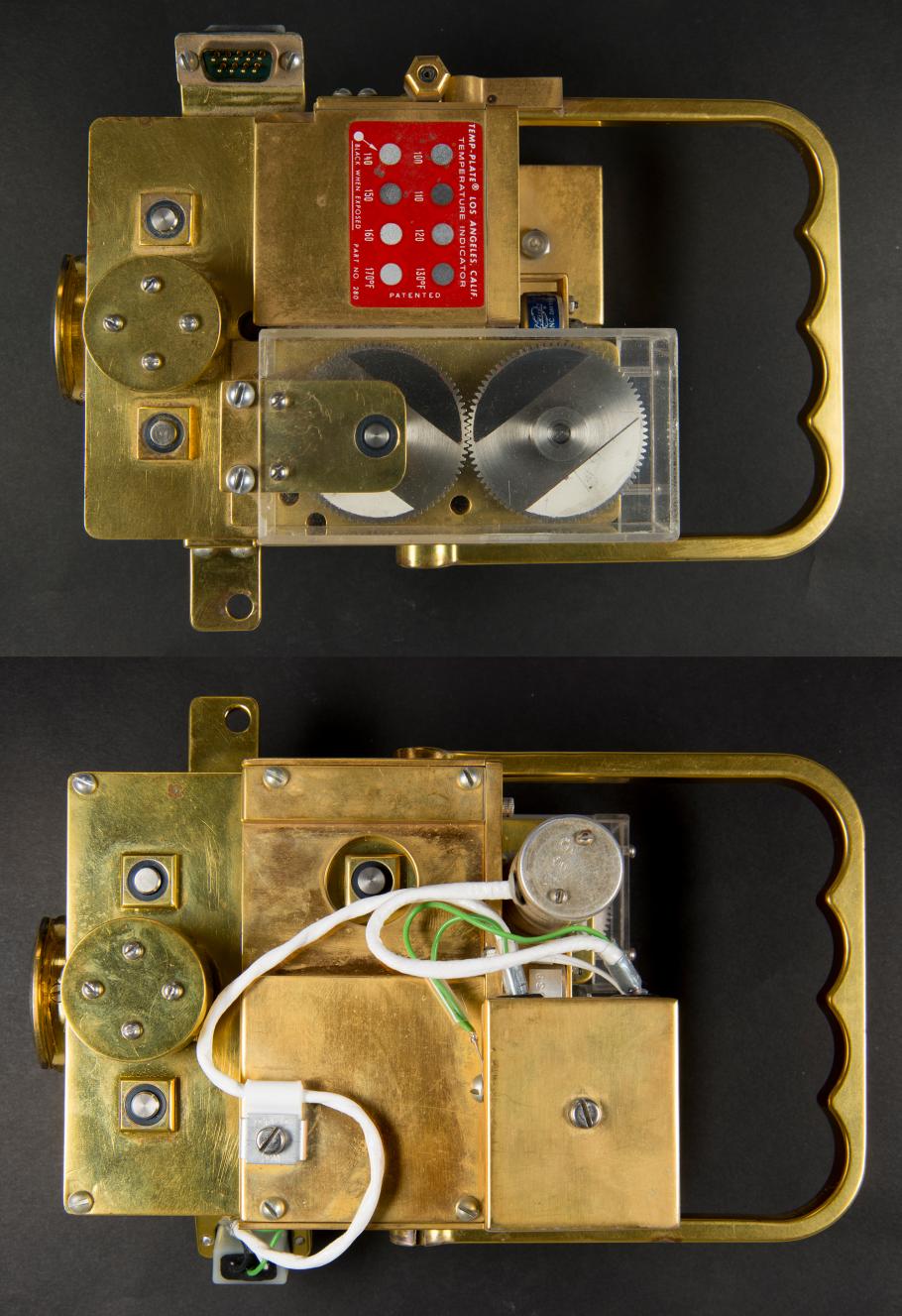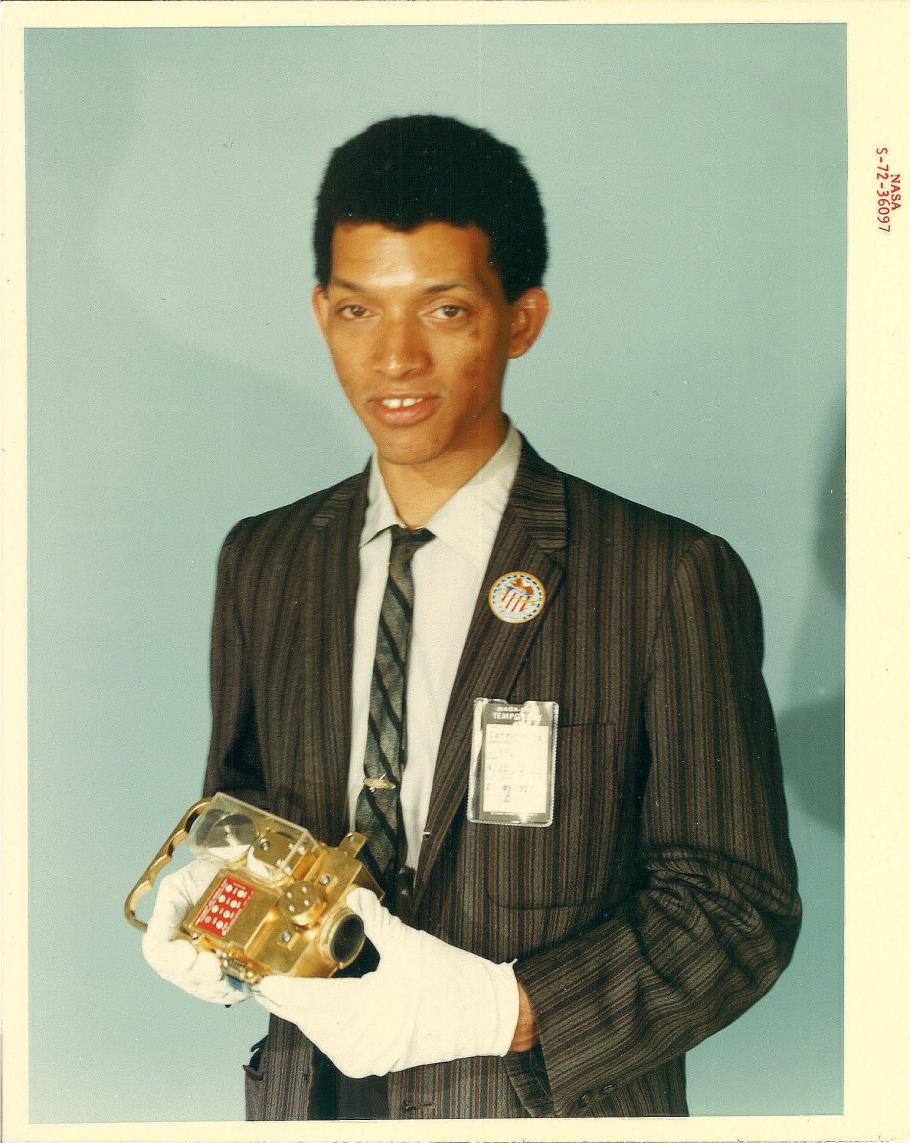
What’s that Smell? Conserving Apollo 16 Film Transport
Sep 06, 2016
By Robin O’Hern and David DeVorkin
The Museum periodically performs a thorough, physical check of all our objects. We open panels and cases and closely inspect each object for any sign of deterioration due to light, humidity, vibration, or just the march of time. We always hope there are no surprises.
But when conservator Robin O’Hern, gallery inventory coordinator Erin Ober, and their colleagues opened a large chamber in the Apollo to the Moon gallery, they got a shock; an acrid chemical smell.
What could cause such a smell? Robin O’Hern inspected the chamber, which contained a reconstructed camera with parts that had flown to the Moon during Apollo 16. Was the source of the smell degrading plastics or film, and was it causing corrosion to the metal components?
The camera’s gold-anodized magnesium alloy frame did not have corrosion visible on the surface. There was a battery case, but the batteries were long removed. No organic material could be found, but it did seem that the smell was strongest near the camera’s film transport canister.
While Robin inspected the object, Erin Ober searched the Museum’s records for the object and consulted with curators David DeVorkin and Jennifer Levasseur. Erin uncovered diagrams that indicated the film transport canister had flown to the Moon on the original camera in April 1972. The film transport mechanism was operated by astronaut John Young in a series of studies of the Earth’s outermost atmosphere, its “geocorona.” The canister was removed by the astronauts at the end of their mission. In 1992, the film transport mechanism was added to the camera that is now on display at the Museum—students at the Naval Research Laboratory helped clean and polish the camera and installed the film transport.
George Carruthers designed and built the original camera and film assembly. NASA called the device the "Lunar Surface Camera" or the "Far Ultraviolet Camera/Spectrograph." Its primary collecting system was a very sensitive 7.6-centimeter (3-inch) Schmidt camera that was mounted in an altitude-azimuth frame for access to the visible sky. It used electronographic amplification of the optical signal and recorded images and spectra on a roll of nuclear emulsion film that was fed by the film transport mechanism—the component on display at the Museum that was producing the worrisome aroma.
Could the camera still have film inside? If it did have film, where would that film be? The team—curators David DeVorkin and Jennifer Levasseur; conservators Lisa Young, Malcolm Collum, and Robin; and registrar Erik Satrum—decided to remove the film transport from the object so that it could be investigated at the Emil Buehler Conservation Laboratory at the Steven F. Udvar-Hazy Center in Chantilly, Virginia. While there, Robin photographed, researched, and wrote about its construction and condition.
Angelina Callahan at the Naval Research Laboratory along with engineers John J. Hardgrove and Timothy D. Seeley of Lakenheath Electronics Design, agreed to help us investigate whether film was still present in the film transport. They also agreed to visit our laboratory when the camera was ready to be opened and help us make sure nothing historical was damaged in the process. We would have loved to have George Carruthers visit and help too, but he was not available.
When the time came, John, Tim, and Angelina brought their tools along with years of experience. We were all excited to open the film transport to find out what was inside. Would the metal components be completely corroded from exposure to the organic vapors that make up that peculiar smell? Would there be film inside? Tim and John carefully removed outer sections of the camera using the tools they’d brought. Robin recorded the location of each screw and panel and carefully made sure everything was accounted for. For the small hardware, she prepared a foam sheet that would secure and preserve nuts, bolts, and washers pressed into it. Later, Robin would annotate images of the object to record the order of disassembly and the location of hardware.
When John and Tim opened up the last panel to reveal the interior, we were surprised, and relieved, to see that there was only minimal corrosion and that no film was present. The interior of the film transport had four magnesium alloy film spools mounted on stainless steel rods. There were rectangular areas of adhesive residue on two of the film spools from the tape originally used to secure the film in place. The interior cavity was painted matte black over a red primer, possibly a RTV rubber (room temperature vulcanized silicone). Some of the components were made of a black plastic, later identified as Delrin.
Everyone got a whiff of the aroma that had initiated the film transport’s removal. Each, described the smell differently:
“It smells like Methyl ethyl ketone.”
“It smells like cough drops, the really yucky kind.”
“It smells like the dentist.”
The original plan was to close the object the same day, but we ended up wanting more time to reduce corrosion, take high quality images of the interior, and research the smell.
As Robin continued to work on the film transport, she consulted with her colleagues about the smell. Malcolm Collum thought the Delrin plastic components were the most likely source of the smell. Delrin is a polyoxymethylene plastic that was produced by DuPont and used in objects designed for outer space. We expect it would release acetate or formaldehyde compounds, which fit with the way people described the smell.
Robin and Lisa began to analyze and treat the corrosion on the magnesium alloy spools. The spools had darkened circular areas where white corrosion pits were beginning and areas of larger white rounded corrosion products emerging from the surface. They used a scalpel to remove the corrosion without damaging the surface of the spool. The corrosion that was removed was gathered and stored in a glass vial for analysis.
The sample was tested with a silver nitrate spot test and the MQuant Chloride Test strips to determine if chloride ions were a part of the corrosion—chloride ions are a common component of corrosion on metal alloys. But neither test found chloride ions present. The spools and corrosion samples were also analyzed with a portable X-Ray Fluorescence Spectrometer (pXRF) Bruker Tracer III-SD (10-40kV; 90 sec; vacuum) used to determine the elemental composition. The spools are likely magnesium alloyed with aluminum, phosphorus, chromium, iron, nickel, and zinc. The white corrosion contained many of the elements found in the spool as well as silver and bromine. Silver may be a residue from the film or manufacturing process and the bromine may be a cleaning product residue. Bromine may be interacting with the magnesium-aluminum alloy and facilitating corrosion.
After analyzing the corrosion with the available materials and techniques at the Conservation Lab, we asked Angelina if she could put us in touch with somebody at the Naval Research Laboratory (NRL) who could help us analyze the corrosion samples. She introduced us to Edward Lemieux, director of the Center for Corrosion Science & Engineering, who agreed to do the analysis.
Lemieux, along with Sarah Eppard, analyzed the sample with a stereo microscope, an Attenuated Total Reflectance Fourier-Transform-Infrared spectrometer (ATR-FTIR), a Pyrolysis Gas Chromatograph/Mass Spectrometer, and a variable pressure Scanning Electron Microscope (SEM) fitted with an Energy Dispersive X-Ray Spectroscopy (EDAX) detector. The analyses confirmed that the metal corrosion was not related to the smell or off-gassing from the Delrin plastic and was instead due to the reactive nature of magnesium and its alloys:
NRL suggested that the corrosion of the magnesium spools was probably atmospheric corrosion resulting from self-corrosion with exposure to even low levels of humidity. The presence of chloride and bromide, as noted in the report, were also likely to have initiated or as a minimum exacerbated the pitting. Magnesium and its alloys are very reactive and are not particularly corrosion resistant in the presence of either ion. Corrosion resulting from exposure to presence of organic materials was unlikely. (NRL Report Pg. 1)
In the end, to absorb the Delrin compounds that are likely causing the smell and prevent them from potentially damaging the artifact in the future, we added two nylon bags filled with activated charcoal to the interior. The bags of activated charcoal were wrapped around the larger spools inside the film transport and will absorb any vapors off-gassed by the plastic components.
Finally, Tim and John returned to the Conservation Lab to close the film transport case, making sure that each component was replaced exactly as it had been before. The reassembled camera and film transport are now back on display in Apollo to the Moon. Next time you visit and view the camera, we hope this insight into our conservation efforts enhances your experience.
Related Topics
You may also like
Related Objects
We rely on the generous support of donors, sponsors, members, and other benefactors to share the history and impact of aviation and spaceflight, educate the public, and inspire future generations. With your help, we can continue to preserve and safeguard the world’s most comprehensive collection of artifacts representing the great achievements of flight and space exploration.









